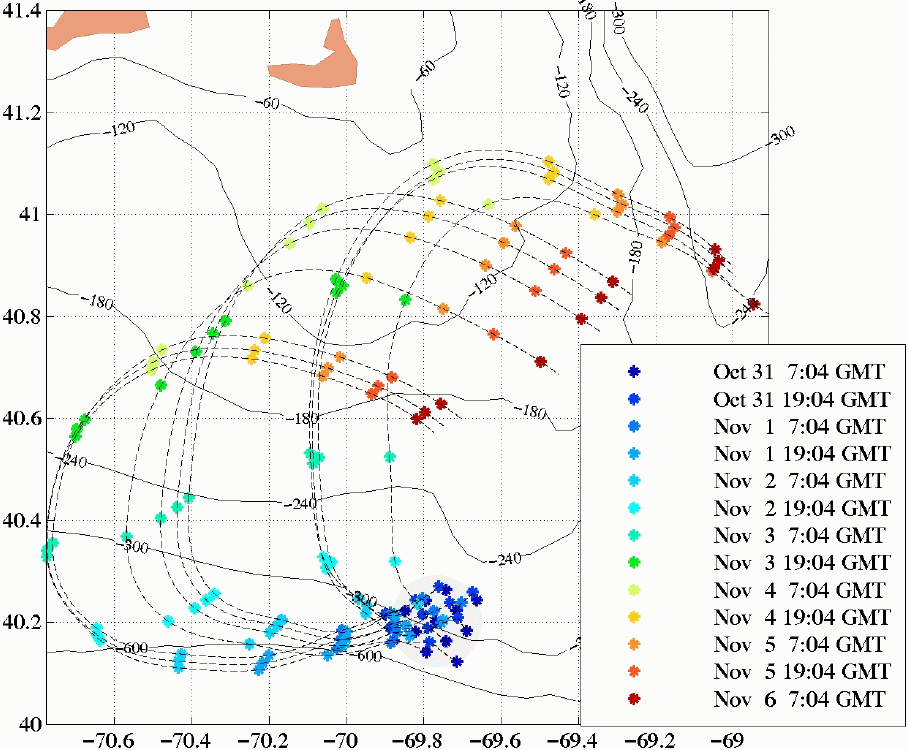
Using the Harvard Ocean Prediction System, the potential paths
of floating debris for the period 31 October - 6 November have been estimated
and forecast. The results presented here were completed at 2 November 2300 EST.
If available information and needs dictate, this forecast will be updated daily.
For this application, a modeling domain with a horizontal resolution of .045
degrees (~5km) and 42 vertical sigma (terrain following) levels is utilized.
The simulation assimilates sea surface temperature from satellite observations
and is forced by Fleet Numerical Meteorology and Oceanography Center (FNMOC)
winds. The simulation is for the period 28 October - 6 November.
The figure below depicts the potential drift paths of floating debris for the period 31 October - 6 November. The gray circle indicates an area 10km in radius from the presumed impact point of Egypt Air Flight 990. Any particle which is located within the gray circle at the time of impact (0700 GMT 31 October) is then tracked for the duration of the simulation period. The paths of these particles are plotted for every model time step. 12 hour intervals are indicated by the asterisks. Bottom contours are labeled in feet.

Potential paths of floating debris: 31 October - 6 November.
(Click on image for larger size version)
Overall, the trajectories of the floating debris are dependent upon
the winds (strength, direction and pattern) and
the internal ocean dynamics (meandering shelfbreak front,
westward sluggish shelf currents and eddies, and Gulf Stream warm-core rings).
The area of possible impact is slightly to the north of an
oceanic front, the shelfbreak front.
The surface currents of the front are westward-southwestward,
meandering approximately along the path of the 300 foot isobath.
During the relatively calm wind period, from Oct 31 0700 GMT up to Nov 2, the
motions of the floating debris depend on their position
with respect to the front.
The debris which are initially trapped in the front
are advected by the currents westward. However, the
debris which are to the north and south of the front
move sluggishly.
Beginning around Nov 2, 1200 GMT,
the winds pick up in strength, towards the north,
becoming very strong on Nov 3, 1200 GMT. During this period,
all simulated debris are moving rapidly primarily northward, turning
in the north-northeast direction,
and away from the shelfbreak frontal area.
Starting late on Nov 3 up to Nov 5 1200 GMT, the wind is
predicted to change direction
to the northeast and to weaken to strong-moderate winds.
All simulated debris are then predicted to deviate
east-northeast. On Nov 6, 1200 GMT, the forecast winds
are to the southeast, and the debris start to move
south-southeast.
Temperature and Velocity Fields
The images below illustrate the 4-dimensional (space and time) simulation which
was utilized
to produce the potential floating debris paths shown above. Daily plots over
the duration of the forecast period are included. Each image shows
the temperature values at the 5 meter depth, overlaid with velocity vectors
at the same depth. The temperature scale is in Celsius and the velocity
scale arrow shown is 50 cm/s. Vectors are not
plotted if the velocity is below 5 cm/s. Note that the forecast period
begins on 2 November.
HOPS is a flexible, portable and generic system for inter-disciplinary
nowcasting, forecasting and simulations. HOPS can rapidly be deployed to
any region of the world ocean, including the coastal and deep oceans and
across the shelfbreak with open, partially open or closed boundaries. Physical,
and acoustical, real time and at sea forecasts have been carried out for more
than fifteen years at numerous sites and coupled at sea biological forecasts
were initiated in 1997. The present system is applicable in waters from 10m depth
to several
thousand meters and the heart of the system is a primitive equation physical
dynamical model.
This page has been accessed at least
times since 3 November 1999. This page was last revised at 0930 4 November 1999.